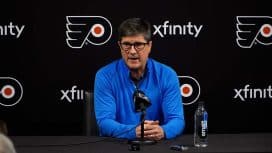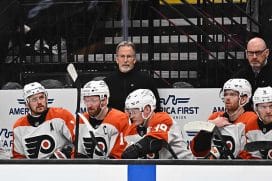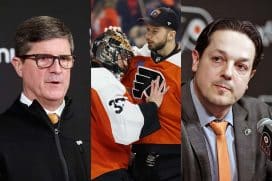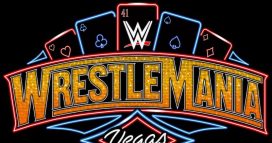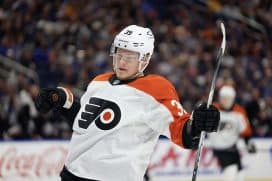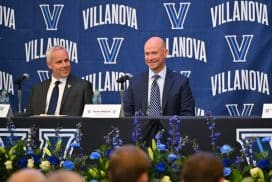Eagles
Club Eleven: Coincidence for Champions?
By Matt Albertson, Historical Columnist
Carson Wentz is just the fourth Eagles primary quarterback to join "Club Eleven" since the team's founding in 1933. I'll let you in on a secret: the other three quarterbacks were pretty special, while two of them led the Eagles to three championships. When I say primary quarterback, I mean the player who topped the depth chart (sorry, 1987 strike scab Scott Tinsely and early 1970s backup Rick Arrington).
Wentz continues to improve and meet/exceed the franchise's expectations after drafting the North Dakota native second overall in the 2016 draft. Through 26 games, Wentz has led the Eagles to a 16-10 record, thrown for over 6,000 yards including 41 touchdowns with a 61.5 completion percentage and an 87.5 QBR. Not bad! In 2017 alone, Wentz paces the NFL with 25 touchdown passes while throwing for nearly 2,500 yards and boasting a 103.4 QBR. More importantly, he's led the birds to a league best 9-1 record, leading many pundits (and fans) to believe that the Eagles are the team to beat in the NFC and/or NFL.
Primary quarterbacks who wear #11 in Eagle green have typically brought great fortune to the franchise and its fanbase. Norm Van Brocklin, Bobby Thomason, and Tommy Thompson each donned #11 and made All-Pro teams and/or Pro Bowls while with the Eagles. Thompson helped lead the Eagles to the 1947, 1948, and 1949 NFL Championship games, winning in '48 and '49 while Van Brocklin led a scrappy team to the 1960 championship over Vince Lombardi's Green Bay Packers; that 1960 team was the only team to ever beat a Lombardi coached Packer squad in the postseason.
The 1960 championship was unlikely but so was Van Brocklin's arrival in Philadelphia. "The Flying Dutchman" made a name for himself with the Los Angeles Rams, who drafted him out of the University of Oregon in 1949. He won a championship with the Rams as a backup to future Hall of Famer Bob Waterfield in 1951 and from 1952-1957 set the league on fire, earning all-pro honors in 1952, 1954, and 1955. But displeasure with coaching led him to retire at the age of 31 after the 1957 season. On May 27, 1958, the Philadelphia Inquirer announced that the Rams traded Van Brocklin to the Eagles for two players and a draft pick. "Pro coaches say the easiest way to get a football downfield is to throw it", the Inquirer explained, "They admit there is a catch: very few men are proficient in this easy art. Norman Mack Van Brocklin is one of the few 'easy aces.'"
Van Brocklin's passing feats seem pedestrian today, especially considering that the passing game was still in its infancy in terms of complexity and offensive style. But "The Flying Dutchman" holds a record that has surprisingly survived to this day: On September 28, 1951, Van Brocklin started for injured Bob Waterfield and threw for a galactic 554 yards and five touchdowns, four of which were to Elroy "Crazy Legs" Hirsch. Despite only starting one other game in 1951 Van Brocklin (who did play in all 12 games) threw for over 1,700 yards (starting quarterback Waterfield threw for 1,500) which ranked 2nd in the NFL.
Van Brocklin brought his surly leadership and aura to an Eagles team that hadn't made the postseason nor won more than 7 games in a single season since 1949. The Inquirer furthered "On-field he has a disposition totally intolerant of losing. Generally, he gets along with people, except those he consideres adverse to his goal, winning games. Then he's apt to tee off, on officials or players or even his coach." The Dutchman didn't like losing but came to Philadelphia? What a guy! The Dutchman's Philadelphia career began slowly, with the birds winning only 2 games in 1958, but improved to 7-5 in 1959 before breaking through in a big way in 1960, going 10-2, including SIX come from behind victories, and winning the 1960 NFL championship. Van Brocklin retired after the 1960 season, a season in which he won a championship, the Associated Press MVP and earned First Team all-pro honors. Some swan song.
Van Brocklin overshadows his Club Eleven predecessors Bobby Thomason and Tommy Thompson, but both were excellent quarterbacks in an era where running backs dominated the game. Both Van Brocklin and Thomason were drafted by the Los Angeles Rams in 1949 and shared bench duties with established starter Bob Waterfield. The Rams traded Thomason to the Green Bay Packers in 1951 who flipped him to Philadelphia in 1952.
Eagles quarterback Bobby Thomason drops back to pass in a 1952 game against Cleveland. (YouTube)
Thomason was brought in to backup Adrian Burk but ended up splitting time with him until Burk's retirement in 1956. Thomason was the first Eagles quarterback to throw for over 400 yards on November 8, 1952 in a 30-7 rout of the New York Giants at Connie Mack Stadium in Philadelphia. Stan Baumgartner of the Philadelphia Inquirer noted "Executing aerials with a needlepoint accuracy that ripped the visitors' highly-touted umbrella defense to shreds, Thomason completed 22 of 44 attempts for 437 yards, fourth best in league history, and four touchdowns…" No Eagle quarterback would throw for more than 400 yards in a game until Sonny Jurgenson in 1961, but his 437 yards remained the club record for most yards thrown in a single game until 1989 when Randall Cunningham threw for 447 yards against the Redskins.
Thomason led the birds to another astonishing upset on the last game of the 1953 season when he led the Eagles to a 42-27 upset of the 11-0 Cleveland Browns. The wily sidearm quarterback out-threw Cleveland's Otto Graham by passing for 331 yards and three touchdowns before a capacity crowd at Connie Mack Stadium. Thomason threw for 21 touchdowns in 1953, helped lead the Eagles to a 7-4-1 record (6-2 as the starter), and earned his first of three Pro Bowl selections. In total, Thomason threw for 8,124 yards, 57 touchdowns, and carried a 50% completion percentage (which was then the mark of a good quarterback).
The Thomason-Burk platoon took over for the first Club Eleven member Tommy Thompson. Thompson joined the Eagles in 1941 and was the primary signal caller when the Eagles made the NFL championship game in 1947, 1948, and 1949, winning the titles in 1948 and 1949. Between 1947 and 1949, Thompson threw for 5,372 yards and 57 touchdowns, helping the team to a 28-7-1 record in that span. Over eight seasons with Philadelphia, Thompson threw for 10,240 yards and 91 touchdowns and is just one of three quarterbacks who won multiple championships but are not members of the Hall of Fame. In 1948, the Tulane product led the league with 25 touchdown passes, followed by Sammy Baugh's 22 (no other quarterback had more than 14) and led the league in passer rating.
Tommy Thompson's 1950 Bowman football trading card (Matt Albertson/Sports Talk Philly)
T. J. Troup of the Professional Football Researchers Association explained in 2001 that "Tommy Thompson has been somewhat overlooked. From 1947-1949, Thompson threw 661 passes and had only 37 intercepted, 5.59 percent. The league average for the decade of the 1940s is 9.06 percent." Thompson also espoused a sense of moxie. Eagle Hall of Famer Chuck Bednarik recalled "The thing I remember is his confidence…I was a rookie in 1949, Tommy was a lot older. He'd say to me, 'Who are we playing this week?' I'd tell him, the Bears, the Giants, whoever it was. He'd say, 'Ahh, we'll beat the bums.' It always made me feel good." Although Steve Van Buren was the main cog of the Eagle offense in the late 1940s, head coach Earl "Greasy" Neale said that Thompson was the key, calling nearly every play. Another teammate Al Wistert agreed: "I think the real key to those titles was Tommy Thompson. He wasn't just a leader or a passer, although he was outstanding as both. He was much more. He had those indefinable qualities that make a player a winner. And he could transfer those to the rest of the team. Without Tommy, we still would have been a team of stars. But I don't know if we would have been a great team – a championship team."
But Thompson wasn't just a great quarterback. He was also a good defensive back, playing safety and intercepting 12 passes and returning kicks prior to his entrance into military service during World War II in 1943 and 1944. (He earned a Purple Heart when he was wounded during the second landing wave on D-Day at Normandy in 1944.) When he returned to the Eagles in 1945, he only played quarterback.
The moral of the story? Eagle primary quarterbacks who wear #11 are a special breed. Carson Wentz appears to be the next field general to carry the Club Eleven torch as the Eagles charge towards what fans hope is a very special season and career.
